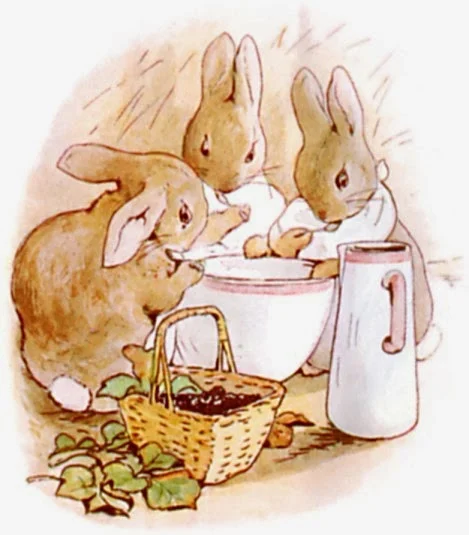 |
| Flopsy, Mopsy, and Cotton-tail had bread and milk and blackberries for supper. |
Helen Beatrix Potter (28 July 1866 – 22 December 1943) was an English
author, illustrator, natural scientist and conservationist best known
for her imaginative children’s books featuring animals such as those in The Tale of Peter Rabbit which celebrated the British landscape and country life.
Born into a privileged Unitarian family, Potter, along with her
younger brother, Walter Bertram (1872–1918), grew up with few friends
outside her large extended family. Her parents were artistic, interested
in nature and enjoyed the countryside. As children, Beatrix and Bertram
had numerous small animals as pets which they observed closely and drew
endlessly. Summer holidays were spent in Scotland and in the English
Lake District where Beatrix developed a love of the natural world which
was the subject of her painting from an early age.
She was educated by private governesses until she was eighteen. Her
study of languages, literature, science and history was broad and she
was an eager student. Her artistic talents were recognized early.
Although she was provided with private art lessons, Potter preferred to
develop her own style, particularly favouring watercolor. Along with her
drawings of her animals, real and imagined, she illustrated insects,
fossils, archeological artifacts, and fungi. In the 1890s her
mycological illustrations and research on the reproduction of fungi
spores generated interest from the scientific establishment. Following
some success illustrating cards and booklets, Potter wrote and
illustrated The Tale of Peter Rabbit publishing it first
privately in 1901, and a year later as a small, three-color illustrated
book with Frederick Warne & Co. She became unofficially engaged to
her editor Norman Warne in 1905 despite the disapproval of her parents,
but he died suddenly a month later, of leukemia.
With the proceeds from the books and a legacy from an aunt, Potter
bought Hill Top Farm in Near Sawrey, a tiny village in the English Lake
District near Ambleside in 1905. Over the next several decades, she
purchased additional farms to preserve the unique hill country
landscape. In 1913, at the age of 47, she married William Heelis, a
respected local solicitor from Hawkshead. Potter was also a
prize-winning breeder of Herdwick sheep and a prosperous farmer keenly
interested in land preservation. She continued to write, illustrate and
design spin-off merchandise based on her children’s books for Warne
until the duties of land management and diminishing eyesight made it
difficult to continue. Potter published over twenty-three books; the
best known are those written between 1902 and 1922. She died on 22
December 1943 at her home in Near Sawrey at age 77, leaving almost all
her property to the National Trust. She is credited with preserving much
of the land that now comprises the Lake District National Park.
Illustrations posted here are from The Tale of Peter Rabbit by Beatrix Potter.
 |
| Mrs Rabbit, ” you may go into the fields or down the lane, but don’t go into Mr. McGregor’s garden: your Father had an accident there; he was put in a pie by Mrs. McGregor.’ |
 |
| Peter ate some lettuces and some French beans; and then he ate some radishes from Mr. McGregor’s garden. |
- Beatrix Potter’s fossils and her interest in geology – B. G. Gardiner
- Works by Beatrix Potter at Project Gutenberg (plain text and HTML)
- Collection of Potter materials at Victoria and Albert Museum
- Beatrix Potter online feature at the University of Pittsburgh School of Information Sciences
- Beatrix Potter in Cumbria
- Beatrix Potter Society, UK
- Beatrix Potter’s World
- Frederick Warne and Company
- Beatrix Potter, A Life in Nature
- Beatrix Potter Tour of the Lake District
- Preschool Resource About Peter Rabbit

No comments:
Post a Comment
Welcome, I publish commentary closely connected to the topic. Thank you for participating.